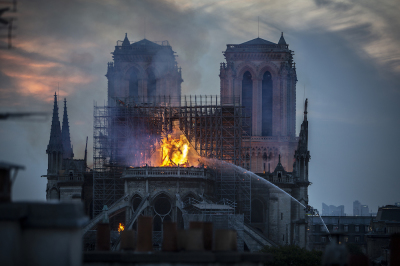The parable of Notre Dame

What happened at Paris’ Cathedral of Notre Dame on April 15 is a searing parable for the global Church of Jesus Christ in all its forms, designations and denominations in our time.
I confess to a great love for cathedrals. The soaring design of the massive sanctuaries arose from hearts and minds that understood the reality and importance of God’s transcendence. Through Isaiah, God reveals that “I dwell on a high and holy place. And also with the contrite and lowly of spirit in order to revive the heart of the contrite.” (Isaiah 57:15)
That’s the message-in-architecture proclaimed by these grand buildings. To stand in a Notre Dame is to be simultaneously reminded of one’s “lowliness” and God’s exalted being.
The cathedrals represent something we have lost in our secularizing frothing—the sense of consecrated space. On the morning after the Notre Dame conflagration I drove to a Catholic church in my community, and entered its chapel that had been set apart—consecrated—for prayer. I needed to “come aside” and be with Jesus in the quiet space.
There I remembered a blistering day a decade ago in the Paris neighborhood of Montmartre. My wife and I were about to climb the big stairway leading to the Sacre-Coeur (Sacred Heart) Basilica sitting on a high perch above the city. We suddenly heard horrid music coming from a platform on the edge of the mount, below the big church. Black T-shirts identified the band as satanists. They seemed to want to show their defiance of the very God in whom they did not believe.
Then Irene and I finally entered the Basilica, and sat with other tourists and worshippers. Soon I heard another kind of music. A nun brought in a cluster of children. She sang to them about Jesus, and prayed over them in her beautiful French. The contrast with the monstrous noise from the satanists was striking.
I understood afresh what “sanctuary” truly means, and the sadness in our loss of that idea in our time.
A few years later Irene and I and a group traveling with us were in Notre Dame itself during a Sunday Mass. At its conclusion the great pipe organ shouted the glory of God to the rooftop.
Perhaps the very roof burned out by the flames of April 15.
No, I have not abandoned my evangelical faith for Catholicism. But I do grieve over the severe reductions of the Reformation—especially the radical reformation wherein lie my Baptist roots. The iconoclasts destroyed beauty and art that proclaimed God’s glory. They swept their gathering places bare of the things that hush us when we sit, stand, or kneel before them.
The symbols and representations are not to become the objects of our worship, but, as Frances Schaffer reminded us, point us to the God who is Himself the essence and giver of all beauty.
While the reformers were busy getting rid of things, the Roman Catholics were clutching too tightly on things that really needed to go—primarily the institutionalization of rites and objects that could lead easily to idolatry.
But in their zeal to chop away, the radical reformers left us with a faith that has, in our day, displaced the sense of God’s transcendence and holiness with the hyper-immanent selfie religion that titillates but does not transform. One friend described the “worship service” at her church as “a rock concert with a few Bible verses thrown in.”
How can we reverence human life and the environment when we don’t reverence the Creator? How can we have anything but antinomian, immoral, amoral culture when we have forgotten that God is holy, and that sin is a reality that grieves His heart and calls down His judgment? How can we not have political leaders whose characters were shaped in the gutters when we ourselves drink from the murk—as the current spate of morally compromised church leaders reveals?
Whenever the church sinks, the culture is sucked down like a hapless swimmer in the vortex of the sinking Titanic.
Yet there is encouragement. I spent a year studying the Welsh Revival of 1904-5, and wrote a recently released book titled, “Call Down Lightning.” What I discovered generally about revival is that when the crisis deepens, and the flames seem to consume everything in sight, the Lord of history is up to something big.
That’s why I think the burning of Notre Dame—tragic as it is—is a searing parable for the church generally and universally in our day.
Devastating spiritual-philosophical-legal fires will roar upon churches everywhere in the years ahead, and we must be ready. As I have written previously, the intensifying strategy of the secularist-progressivist movement toward the church in all its forms is marginalization, caricaturization, vilification, criminalization, and finally elimination.
Initially, the conflagrations will be destructive. The searing heat of tribulation is already burning at the heart of Christian communities across the world. The West will begin to feel the heat with mounting intensity.
But the good news is that from the ashes will rise a new church for the ends of the ages.
Nothing shows this as beautifully as the widely circulated photo of Notre Dame’s golden altar cross glowing through the smoke on the Monday of Holy Week.
It is as if God is telling us that Jesus Christ and His cross is what it’s all about, and what really matters after the flames have consumed all else.
What a message for Easter, 2019!





















